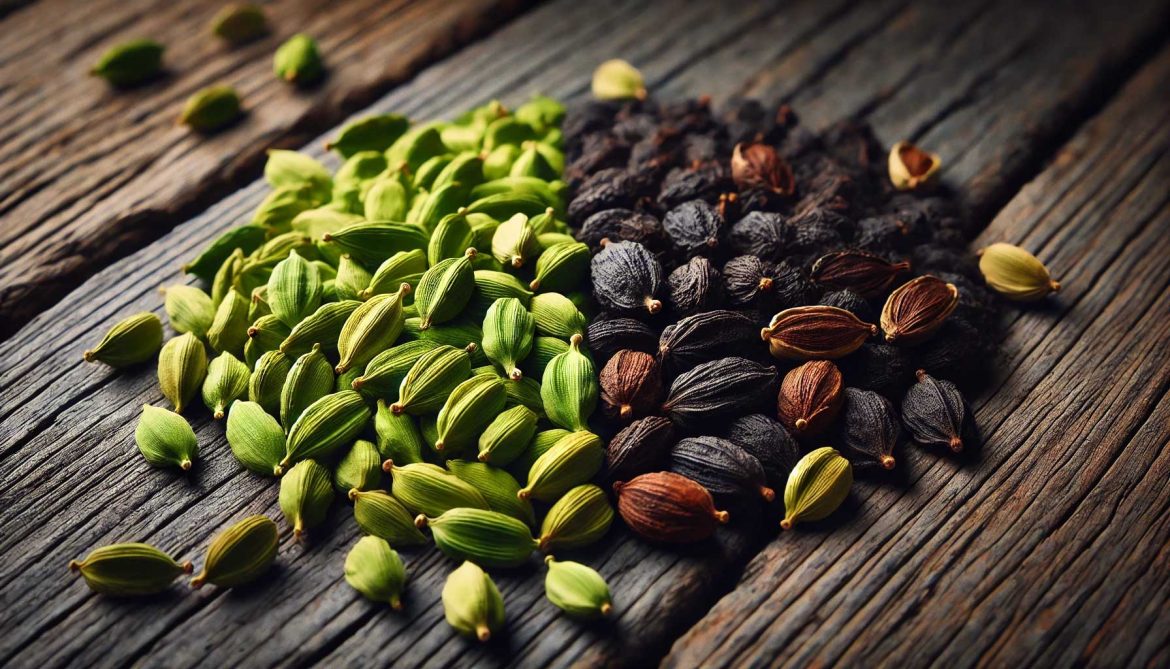Cardamom, often referred to as the “Queen of Spices,” is celebrated for its exquisite flavor, rich aroma, and extensive uses in cooking and traditional medicine. With two primary varieties—green cardamom and black cardamom—each offering distinct characteristics, understanding their differences can open new dimensions in your culinary and health journey. In this expanded guide, we will explore these two spices in depth, from their origins and properties to their diverse applications.
What Is Cardamom?
Cardamom comes from the seed pods of plants in the ginger family (Zingiberaceae). It is one of the most prized spices globally, with a history that dates back to ancient Egypt, where it was used for incense, medicine, and flavoring. Its aromatic seeds are stored in pods, which protect their delicate flavors.
Types of Cardamom
- Green Cardamom (Elettaria cardamomum): A tropical plant primarily grown in India and Sri Lanka.
- Black Cardamom (Amomum subulatum): A plant native to the Himalayan regions, Bhutan, and Nepal.
Each variety is processed differently and suited for specific culinary and medicinal purposes.
Origins and Cultivation: Where Do They Come From?
Green Cardamom
Green cardamom thrives in tropical, humid climates, with India being the largest producer. It requires fertile soil, ample rainfall, and shaded conditions for optimal growth. The pods are harvested just before they ripen to retain their bright green color and fresh flavor.
Black Cardamom
Black cardamom, in contrast, is cultivated in the cooler climates of the Himalayan foothills. The pods are harvested and then dried over open flames, which imparts their signature smoky aroma. This process is labor-intensive, making black cardamom a valuable spice in regional cuisines.
Visual and Physical Differences
Green and black cardamom are easily distinguishable by their appearance:
- Green Cardamom: Small, smooth pods with a bright green color. The seeds inside are sticky and intensely aromatic.
- Black Cardamom: Larger, rough-textured pods with a dark brown to black exterior. The seeds have a slightly resinous quality.
Aroma and Flavor Profiles: A Closer Look
Green Cardamom
- Aroma: Sweet, floral, and slightly citrusy.
- Flavor: Light, with delicate notes of mint and eucalyptus.
Green cardamom is often described as elegant and subtle, making it ideal for desserts and beverages.
Black Cardamom
- Aroma: Strong, smoky, and woody.
- Flavor: Bold, earthy, and slightly bitter, with hints of menthol.
Black cardamom has a more robust and assertive flavor profile, perfect for hearty and savory dishes.
| Aspect | Green Cardamom | Black Cardamom |
|---|---|---|
| Size | Small | Large |
| Aroma | Sweet and floral | Smoky and earthy |
| Flavor Intensity | Mild and delicate | Strong and bold |
Culinary Uses: Green vs. Black Cardamom
Green Cardamom in Cooking
Green cardamom is versatile and used in both sweet and savory dishes. Its delicate flavor enhances the following:
- Desserts: Puddings, ice cream, cakes, and custards.
- Beverages: Chai tea, spiced coffee, and lassis.
- Curries: Light, creamy curries with vegetables or chicken.
Black Cardamom in Cooking
Black cardamom is reserved for robust, savory recipes. It is commonly used in:
- Stews and Soups: Adds depth to slow-cooked dishes like lentil stew.
- Rice Dishes: A key ingredient in biryanis and pulao.
- Spice Mixes: Garam masala and other blends for grilled meats.
Nutritional and Health Benefits
Green Cardamom
- Digestive Health: Stimulates appetite and reduces bloating.
- Oral Hygiene: Its natural oils freshen breath.
- Antioxidants: Helps fight inflammation and reduce oxidative stress.
Black Cardamom
- Respiratory Support: Opens airways and relieves congestion.
- Detoxification: Promotes kidney health.
- Anti-Bacterial Properties: Protects against infections.
Processing and Preparation: From Pod to Plate
Harvesting
- Green Cardamom: Hand-picked before full ripening.
- Black Cardamom: Harvested and smoked for preservation.
Grinding
For optimal flavor:
- Green Cardamom: Lightly crush pods to release their oils before use.
- Black Cardamom: Toast whole pods in oil or grind for spice blends.
Substitutes and Pairings
Substitutes for Green Cardamom
- Cinnamon or nutmeg for desserts.
- Vanilla for beverages.
Substitutes for Black Cardamom
- Smoked paprika or cloves in savory recipes.
Pairing Ideas
Enhance your dishes by pairing cardamom with complementary ingredients:
- Green Cardamom: Works well with rose water, almonds, and saffron.
- Black Cardamom: Complements cumin, star anise, and peppercorns.
Storage Tips for Maximum Freshness
Cardamom’s essential oils are volatile, so proper storage is critical:
- Use airtight containers.
- Store in a cool, dark place.
- Avoid grinding until just before use.
Fun Facts About Cardamom
- Cardamom is the third most expensive spice in the world, after saffron and vanilla.
- Green cardamom is a popular ingredient in Scandinavian pastries.
- In traditional Indian weddings, cardamom is used to flavor celebratory drinks.

FAQs About Black and Green Cardamom
1. Can I use black cardamom in desserts?
No, its smoky flavor is too strong for sweet dishes.
2. Is green cardamom expensive?
Yes, due to labor-intensive harvesting and processing.
3. How is black cardamom smoked?
It’s dried over open flames, giving it a distinct flavor.
4. Are there other varieties of cardamom?
Yes, white cardamom exists but is artificially bleached.
5. How long does cardamom stay fresh?
Whole pods stay fresh for up to a year if stored properly.
Conclusion: Choosing the Right Cardamom
Both green cardamom and black cardamom are essential in different culinary contexts. While green cardamom elevates sweet and subtle dishes, black cardamom adds smoky depth to savory recipes. Understanding their unique characteristics allows you to experiment and create rich, flavorful meals.



